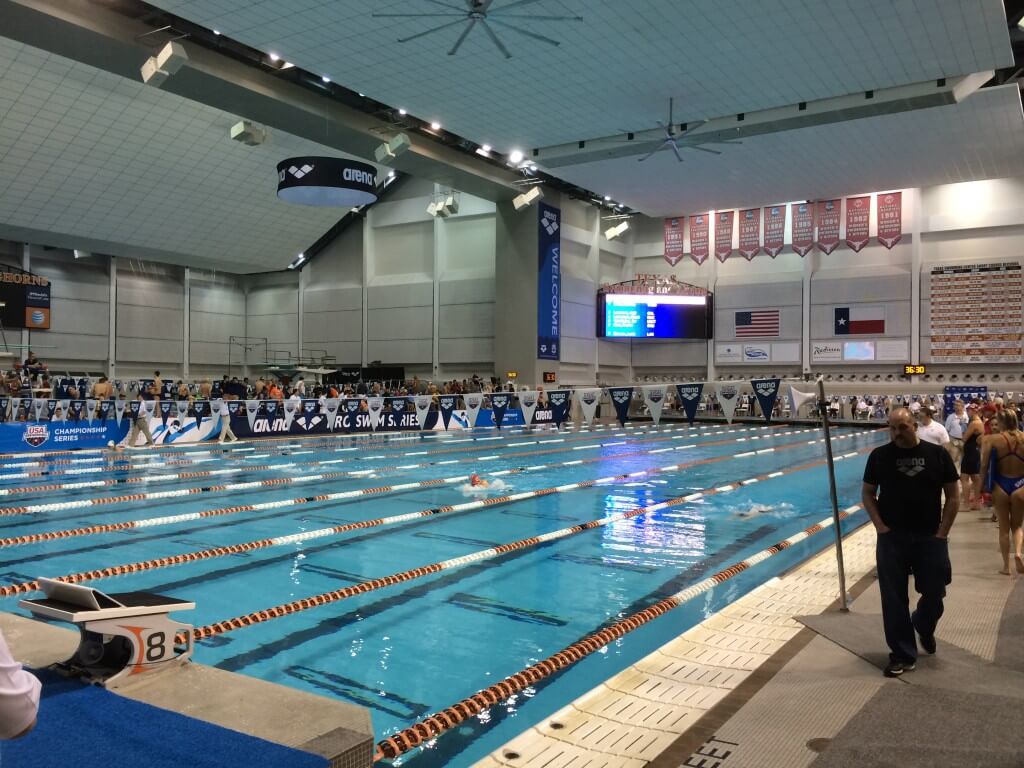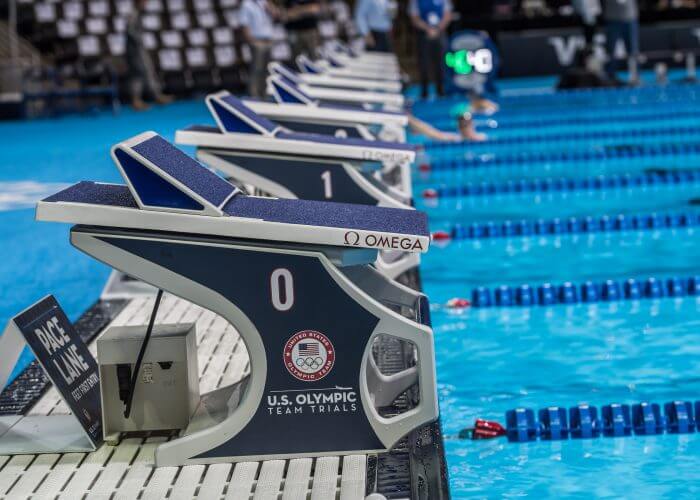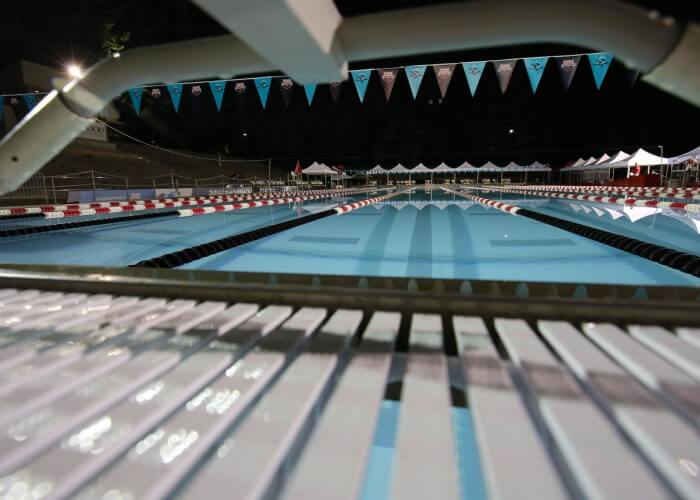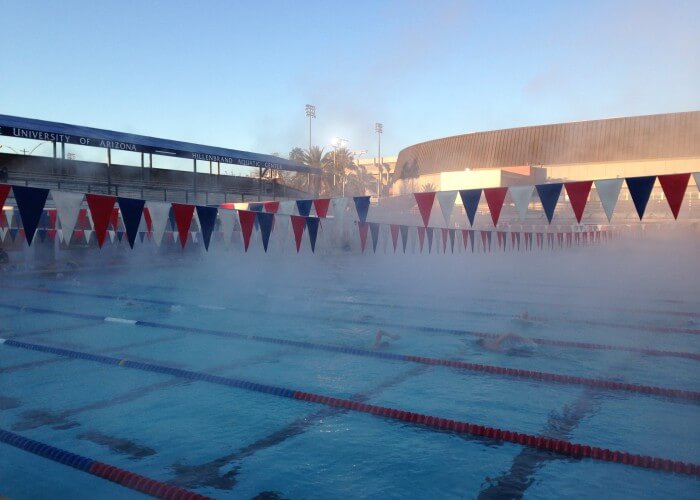What Makes a Pool Fast?

By Devin Javens
Only swimmers know and understand the feeling of a fast pool. Something about the feeling can resemble that of euphoria, leaving you feeling as if you possess the swimming capabilities of Michael Phelps or Katie Ledecky. Swimmers constantly refer to pools as either fast or slow; however, what classifies a pool as one or the other? Is it just a feeling, or is there actual evidence to back up swimmers’ claims?
Developments within pool technology have definitely contributed to the speed of a pool, resulting in that quick feeling that swimmers experience while competing in a pool that has been engineered to produce fast swims.
Just more than a decade ago, starting blocks and backstroke starts looked a lot different than they do today. These days, it’s rare to see a state-of-the-art facility that has blocks without a fin or backstroke ledge. However, a decade or so ago this equipment wasn’t seen at even the highest levels of competition. It wasn’t until 2009 that starting block fins were used in international competition at the Swimming World Cup. Even more shockingly, it was only nine years ago in 2013 that FINA approved the new concept of backstroke ledges. However, this equipment significantly improves the speed and effectiveness of a swimmer’s starts, setting a swimmer up for a faster race than if this equipment was not being used.

Photo Courtesy: Peter H. Bick
Ultimately, both the use of the fin and ledge allow for a more powerful start. According to Rhett Allain‘s article from Wired.com, a swimmer is able to exert the maximum amount of frictional force off the block since the fin prevents any slipping that could potentially occur, thus contributing to a faster start. The same idea applies to the use of backstroke ledges. Because of constant slipping during backstroke starts at all levels of competition, backstroke ledges were created to decrease the risk of slipping – a risk that was unavoidable to even the most elite swimmers.
In addition to starting blocks, evidence supports other factors that can qualify a pool as fast or slow. Draining systems, depth and temperature can all determine the speed of a pool. British swimmer and silver medalist Chris Walker-Hebborn recalls his experience with an ineffective draining system: “Years and years ago, when pools had gutters on the side and walls, if you were on the outside lane then the waves were splashing back and hitting you.”
However, in today’s fastest pools, swimmers in end lanes are no longer at a disadvantage. These pools now have draining systems that allow the water to fall into drains at the pool’s edges rather than create waves. These effective draining systems consist of deep and level gutters that are able to drain any excess water without overflowing. Less excess water equals less waves, which equals faster swimming.

Photo Courtesy: Nicholas McMillan
Waves can also be prevented by the depth of a pool and lane lines. In addition to the overflow of excess water being the cause, waves are also created simply through the act of swimming. Because of the movement of water, having waves is bound to happen. However, the best method to reduce the amount of waves created and decrease the chance that they’ll affect a swimmer’s performance is through a pool’s depth. When swimming in shallow water, waves are able to bounce off of the bottom of the pool and engulf the swimmer; however, by increasing the pool’s depth, waves have more room to travel and fade rather than hitting and fully impacting the swimmer.
The perfect pool temperature can also impact performance. If the pool water is too hot, then athletes are at risk for overheating and their muscles can over-relax, which can result in low energy levels. However, if the pool is too cold, then muscles can tighten up. Both can result in slow swimming. FINA mandates that competition pools must be between 77 and 82 degrees Fahrenheit. Under these ideal conditions, swimmers are able to effectively compete.

Photo Courtesy: Annie Grevers
It’s more than likely that the feeling of a fast pool is the result of the factors discussed. When it comes down to it, you feel like you’re going fast because all of these factors allow you to go faster than what you’re normally used to. Using equipment like starting block fins and backstroke ledges allow you to fully produce more force resulting in a more powerful start. Additionally, the absence or minimization of waves provides a smoother swim, while a moderate temperature can be effective for peak performance. All of these factors contribute to fast swimming. A fast pool isn’t simply a feeling but a summation of the strategic planning of important factors like these.
All commentaries and research are completed by the author and do not necessarily reflect the views of Swimming World Magazine nor its staff.




Sam Lawman
Meghan ParsonsMackenzie Parsons
so cool!!
Anson Tam
Janelle Thompson Gasaway
MK Gazaway
I think 82 is too hot and 77 may be too cold. 79 is probably the sweet spot.
Starting blocks and fins have nothing to do with what makes a fast “pool.”
40 years ago, Clovis West HS pool, Clovis, CA, put it all together with huge overflow gutters, ten feet water depth, and the best lane lines available at that time. 20 – 25 Years later someone finally decided to help backstrokers start with something besides a slippery, flat wall.
Phil Moriarity Yale invented these blocks back in the 60ies
Dick Beaver Same principle at the IU Nat in Indy. Fantastic pool to race in.
Frank Keefe I was still doing slippery wall backstroke starts until 1965. When did USA swimming finally get around to letting backstrokers have something to put their feet on? Phil’s invention wasn’t in pools clear up to the 1983 Nationals. HUGS
Carrie Hall hi. I swam at IU with Doc C.
Indy came along much later. I’ve followed swimming results at Indy once they started hosting the big meets.
Dick Beaver hi! Doc C was one of the best! I swam with Troy at UF.
Yes, the Indy pool was much later. But they followed suit. It is why it is now one of the fastest pools in the country. We live in Indiana now so my kids have the opportunity to race in that pool. So many memories.
The lines in the pool are very important. The new from Malmsten is a record-breaker!
Needs water first and foremost …
They left out Salt water chlorine…
Does it make a difference whether it is a salt-based pool or chlorine-based?
Did I miss the part about advanced lane line tech, and how much bigger they have gotten since we were swimming in the 70’s? And dont they double them up in some meets, at least on the outside lanes against the walls? As to salt water pools, I imagine for some folks it is marginally faster, but the salt content is so low that probably hard to even measure how much more flotation you have, especially vs ocean water. And lastly, they have finally figured out to turn off the filters during the meets(well most of the big meets) so as not to create a flow in some lanes. I remember swimming in lanes where one direction was always faster than the other, but you only found out after seeing the splits after a race. And this is just the pools and starting blocs, never mind the new suits!!